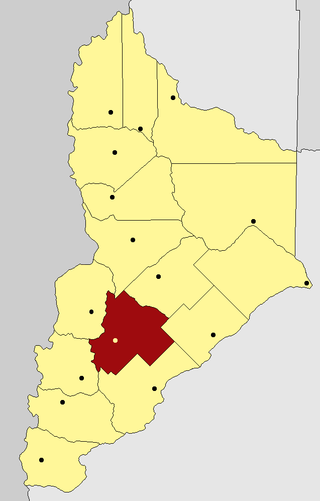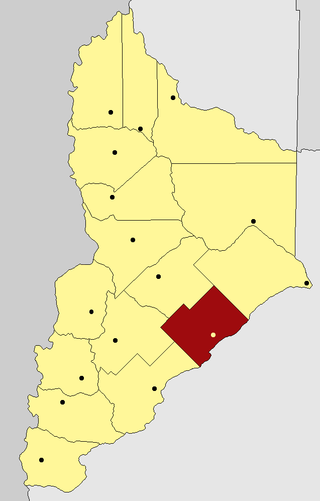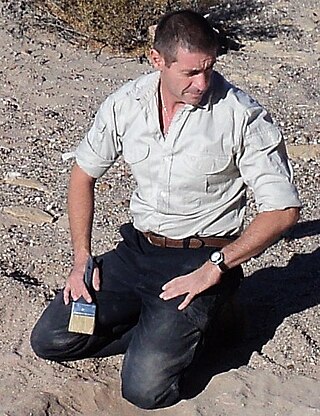
Limaysaurus is a genus represented by a single species of rebbachisaurid sauropod dinosaurs, which lived during the mid-Cretaceous period, about 99.6 to 97 million years ago, in the Cenomanian, in what is now South America.
Herbstosaurus is the name given to a genus of pterosaurs that lived during the Late Jurassic period, in what is now Argentina. In 1969 Argentine paleobotanist Rafael Herbst in the province Neuquén at Picun Leufú dug up a piece of sandstone holding a number of disarticulated bones of a small reptile. At the time it was assumed the rock dated to the Middle Jurassic (Callovian), about 163 million years ago.

The Limay River is an important river in the northwestern Argentine Patagonia. It originates at the eastern end of the Nahuel Huapi Lake and flows in a meandering path for about 380 kilometres (240 mi), collecting the waters of several tributaries, such as the Traful River, the Pichileufú and the Collón Curá. It then meets the Neuquén River and together they become the Río Negro. At this confluence lies the city of Neuquén.

The Pichi Picún Leufú Dam is the third of five dams on the Limay River in northwestern Argentine Patagonia, near the town of Piedra del Águila.
Fernando Álvaro Picún de León is a retired Uruguayan football player. He was a defender. He played for the Uruguay national team at 1999 Copa América in Paraguay.

Confluencia is a department located in the east of Neuquén Province in Argentina. Neuquén, the capital city of the province, is located in this department. The department is named Confluencia after the confluence of the rivers Neuquén and Limay.

Zapala is a department located in the center of Neuquén Province, Argentina.

Pehuenches is a department located in the northeast of Neuquén Province, Argentina.

Catán Lil is a department located in the center of Neuquén Province, Argentina.

Collón Curá is a department located in the southeast of Neuquén Province, Argentina.

Picún Leufú is a department located in the east of Neuquén Province, Argentina.

Piedra del Águila is a second category Municipality and the capital city of Collón Curá Department, located in Neuquén Province, Argentina.
Cynodontosuchus is an extinct genus of baurusuchid mesoeucrocodylian. Fossils have been found from Argentina of Late Cretaceous age from the Bajo de la Carpa Formation, the Pichi Picun Leufu Formation. the Tiupampan Santa Lucía Formation of Bolivia.
Abelichnus is an extinct ichnogenus of dinosaur footprint from the Candeleros Formation and the Rio Limay Formation. The type ichnospecies, Abelichnus astigerrae, was first discovered in Argentina in 1987 and was recorded as the biggest known dinosaur footprint ever discovered. Abelichnus probably grew to a size of 12.5-13 meters long.

Jorge Orlando Calvo was an Argentine geologist and paleontologist working for "Centro de Investigaciones Paleontológicas Lago Barreales".

Leinkupal is a genus of diplodocine sauropod known from the Early Cretaceous of the Bajada Colorada Formation, southeastern Neuquén Basin in the Neuquén Province of Argentina. It contains a single species, Leinkupal laticauda.
Gigantes del Sur is a volleyball team in Neuquén, Argentina. Founded in November 2003, its home stadium is Ruca Che Stadium, Central Park Gym and currently Picún Leufú. It is a member of Liga Argentina de Voleibol – Serie A1, Argentina's top-level men's volleyball league.
The Bajada Colorada Formation is a geologic formation of the southern Neuquén Province in the Neuquén Basin of northern Patagonia, Argentina. The formation belongs to the Mendoza Group and is Late Berriasian to Early Valanginian in age. The formation is renowned for preserving fossil remains of Bajadasaurus pronuspinax, a genus of dicraeosaurid dinosaurs named after the formation.

Bonaparteichnium is a dinosaur ichnogenus known from the Candeleros Formation of Neuquén Province, Argentina. It was named by Jorge O. Calvo in a 1991 paper, alongside the other ornithopod ichnogenera Sousaichnium and Limayichnus. The name of the genus honours Argentinian palaeontology José Bonaparte for his contributions to palaeontology in Argentina. The taxon was named for a 60cm footprint of a bipedal ornithopod; the heel of the track is 28cm long, making it 45% of the track. This length, above that expect for an ornithopod foot, along with the width and robustness of the heel, was the distinguishing trait cited in naming the specimen as a new ichnospecies, and is the basis of the species name tali, referring to word "talon" which means heel. In a 1999 paper Calvo would revise his opinion and consider his three ichnogenera to be synonyms. He noted the extreme similarity of the front half of the foot between Bonaparteichnium and Limayichnus, and that the length and size of a heel in a track is dependent on the method of walking; a bipedal animal walking abnormally low to the ground would produce a track such as that used to name Bonaparteichnium even in lack of a large heel as a genuine anatomical feature. He referred to B. tali as a nomen vanum. In a literature review of hadrosaur ichnotaxa, Ignacio Díaz-Martínez and colleagues considered it a nomen dubium as opposed to referring the specimen to Limayichnus, as they also considered that taxon dubious. They noted that Bonaparteichnium can also be considered a taphotaxon, a term proposed by Spencer G. Lucas to refer to invalid taxa who were thought distinct due to taphonomic distortions.
Villa del Puente Picún Leufú is a village spread through Zapala Department and Catán Lil Department, Neuquén Province, in southwestern Argentina. It was created as a Development Commission at the request of the communities of Puente Picún Leufú and Bajada Los Molles in 1991. The town has 221 inhabitants. Of the 221 inhabitants, 112 live in the municipal administration of the Catán Lil Department and 109 live in the municipal administration located in the Zapala Department.















